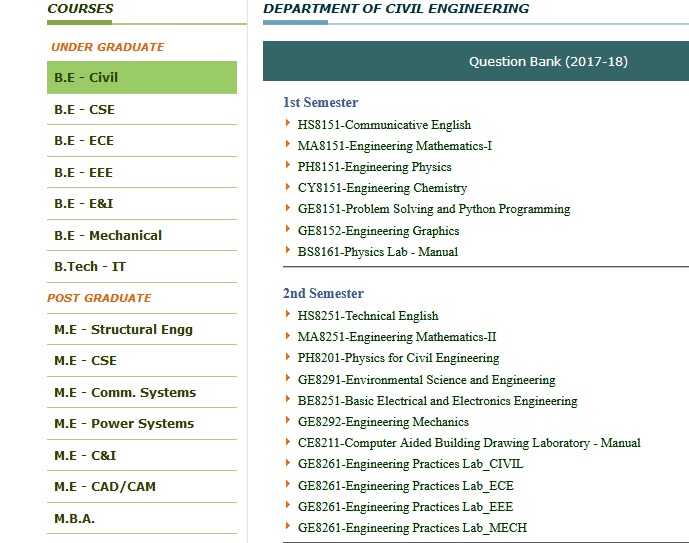IT2302 Information Theory & Coding B.E Question Bank : valliammai.co.in
Name of the College : Valliammai Engineering College
University : Anna University
Department : Information Technology
Subject Code/Name : IT2302-Information Theory & Coding
Degree : B.Tech – IT
Year : III
Semester : V
Document Type : Question Bank
Website : valliammai.co.in
Download :https://www.pdfquestion.in/uploads/va…d%20Coding.pdf
Valliammai Information Theory & Coding Question Paper
Unit – I
Part-A :
1.State source coding theorem.
2.State channel capacity theorem.
3.State channel coding theorem for a discrete memory less channel.
4.What is prefix coding?
Related : Valliammai Engineering College IT2301 Java Programming B.E Question Bank : www.pdfquestion.in/2858.html
5.Define mutual information and its properties.
6.What is average information or entropy?
7.What is a relationship between uncertainty and information?
8.If X represents the outcome of a single roll of a fair die. What is the entropy of X?
9.A code is composed of dots and dashes. Assume that dashes three times longer than dot and has one third of probability of occurrence. Calculate average information in the dot-dash code.
10.Calculate entropy H(X) for a discrete memory less source X, which has four symbols X1,X2,X3 & X4 with probabilities P(X1)=0.4,P(x2)=0.3,P(X3)=0.2 and P(x4)=0.1.

11.Consider an additive white Gaussian noise channel with 4 KHz bandwidth and noise power spectral density ?/2=10-2 w/Hz. The signal power required at the receiver is 0.1 mw. Calculate capacity of this channel.
12.Give the kraft-Mc millan inequality for the instantaneous code.
13.Calculate the amount of information if Pk=1/4.
14.Define efficiency of the source encoder
15.Define rate of information transmission across the channel.
16.Define bandwidth efficiency.
17.Define code variance & code redundancy
18.Write the properties of information
19.List out the parameters to evaluate a encoder as efficient encoder.
20.What is shannon limit?
Unit –II
Part-A :
1.Give the principle behind DPCM.
2.Define statistical encoding and differential encoding
3.What is temporal masking and frequency masking?
4.What is perceptual coding? Give the advantages of perceptual coding.
5.State the advantages of coding speech at low bit rates.
6.What is dolBy AC-1? List the advantages of dolby AC-1.
7.Why subband coding is preferred for speech coding?
8.List the three features which determine the perception of a signal by the ear.
9.What is the major advantage of the adaptive Huffman coding over static Huffman coding?
10.Mention two basic properties of linear prediction.
11.What is quantization noise and on which parameter it depends?
12.Differentiate vocoder and waveform coder?
13.How dynamic Huffman coding is different than basic Huffman coding?
14.How CELP provides better quality than LPC in speech coding?
15.Why is dynamic Huffman coding employed?
16.What is the basic concept of linear coding?
17.What is the principle of adaptive Huffman coding?
18.What is the need for compression techniques?
19.Define processing delay and algorithm delay in speech coders.
20.Explain Run-length encoding.
Unit – III
Part-A :
1.Write the formula for quantization which is used in JPEG compression.
2.Define the terms ‘group of pictures’ and ‘prediction span’ with respect to video compression.
3.List the three tokens available at the output of the entropy encoder in JPEG algorithm.
4.Distinguish between global color table and local color table in GIF.
5.State the intended application of MPEG-1, MPEG-2 and MPEG-3.
6.What is Graphics Interchange Format (GIF)? Mention its main application.
7.What is the need for compression techniques? What do you mean by negative compression?
8.Write two features of TIFF format.
9.Compare JPEG and JPEG 2000 standards.
10.What is known as black-based motion compensation and motion estimation?
11.What do you understand by “GIF Interlaced mode”?
12.What is the significance of D-frames in video coding?
13.State the main application of GIF.
14.Why differential coding is carried out only for DC coefficient in JPEG?
15.Why graphical interchange format is extensively used in the internet?*
16.What is makeup code and Termination code in digitization of documents?
17.Compare MPEG1, MPEG 2, MPEG 3 and H.261.
18.Define I,P,B frames in video
19.Which mathematically algorithm used in GIF,TIFF and digitized documents formats
20.Define DCT and Quantization.